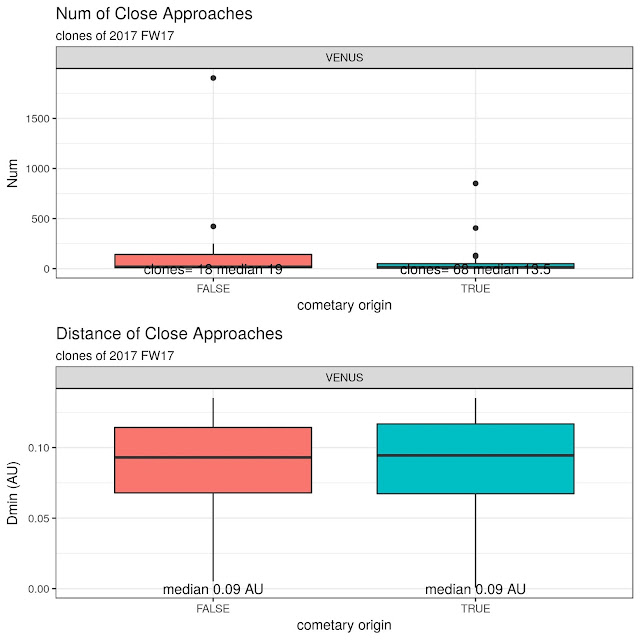This NEO is listed in the page of Asteroids with Comet-Like Orbits maintained by Y. Fernandez.
It was also discussed as an object with a likely cometary origin in some papers, among which I found:
- "On Near-Earth Asteroid Study at Department of Astronomy, Bandung Institute of Technology" by S. Siregar.
- "Assessing the physical nature of near-Earth asteroids through their dynamical histories" by Julio A. Fernández, Andrea Sosa, Tabaré Gallardo, Jorge N. Gutiérrez.
At the time I made this analysis, this Amor was last observed on November 11th, 2017 and the orbit uncertainty is 0 being based on 119 observations acquired in the last 15 years.
JPL Small-Body Database Browser:
Orbital Elements at Epoch 2458000.5 (2017-Sep-04.0) TDB
Reference: JPL 31 (heliocentric ecliptic J2000)
|
Orbit Determination Parameters
Additional Information
|
I simulated 100 clones of this asteroid in the past 10^8 days trying to confirm its possible cometary origin: the goal is to determine whether some
clones might have arrived from the outskirt of the solar system -
arbitrary threshold: 100 AU.
Simulation approach
reference:
J.E.Chambers (1999)
A
Hybrid Symplectic Integrator that Permits Close Encounters between
Massive Bodies''. Monthly Notices of the Royal Astronomical Society, vol
304, pp793-799.
Integration parameters----------------------
Algorithm: Bulirsch-Stoer (conservative systems)
Integration start epoch: 2458000.5000000 days
Integration stop epoch: -100000000.0000000
Output interval: 100.000
Output precision: medium
Initial timestep: 0.050 days
Accuracy parameter: 1.0000E-12
Central mass: 1.0000E+00 solar masses
J_2: 0.0000E+00
J_4: 0.0000E+00
J_6: 0.0000E+00
Ejection distance: 1.0000E+02 AU
Radius of central body: 5.0000E-03 AU
Simulation Results
- 79 out of 100 clones have a cometary like orbit.
- of which: 13 came on a hyperbolic orbit (Vinfinity = 42.1219*sqrt(-0.5/a) --> the minimum absolute value for semi-major axis a was -17.46 AU -->the maximum value for Vinfinity was 7.14 km/s
- 1 out of 100 was discarded because "hit" the sun (due to extremely high eccentricity).
The time when they entered the solar system was distributed as follows:
Min. 1st Qu. Median Mean 3rd Qu. Max.
-272319 -151956 -85380 -100222 -38660 -370
In a graphical form:
The most recent arrival in the solar system could have happened a relatively short time ago compared to other asteroids with a cometary like orbit: year 370 B.C.
A look at the nominal asteroid
The nominal asteroid is one of the 79 clones with a cometary like orbit. It apparently arrived in the solar system about in year 87000 B.C
In the following plots (made with R package ggplot2), the vertical dashed lines show a close encounter with Jupiter.
Close Approaches analysis
For every given planet, every clone had a certain number of close approaches so we can calculate the mean number of close approaches and the mean number of Dmin (distance of the close approach). Even better, we can print a boxplot showing the distribution of the number of close approaches and their distances.
Alessandro Odasso














